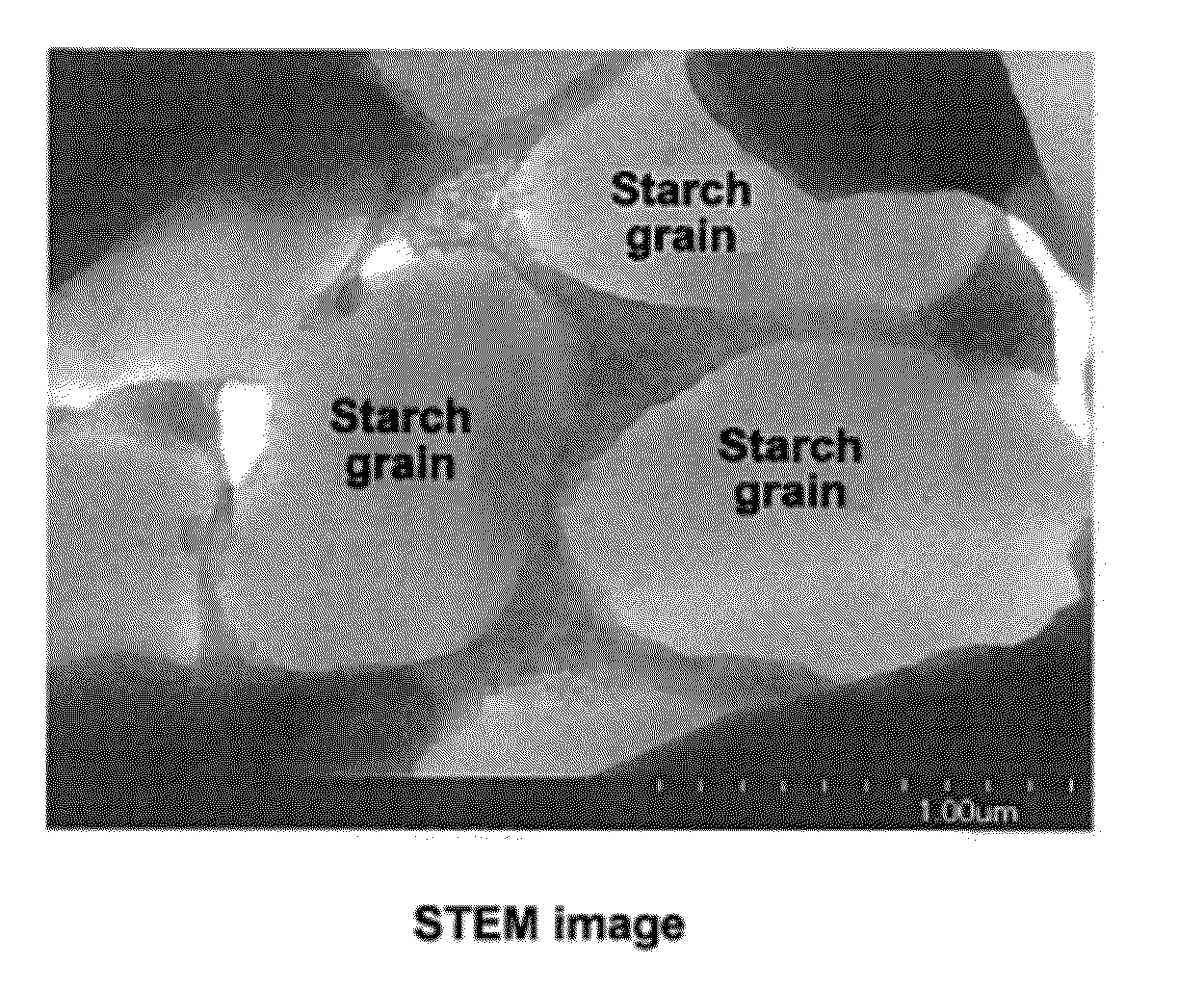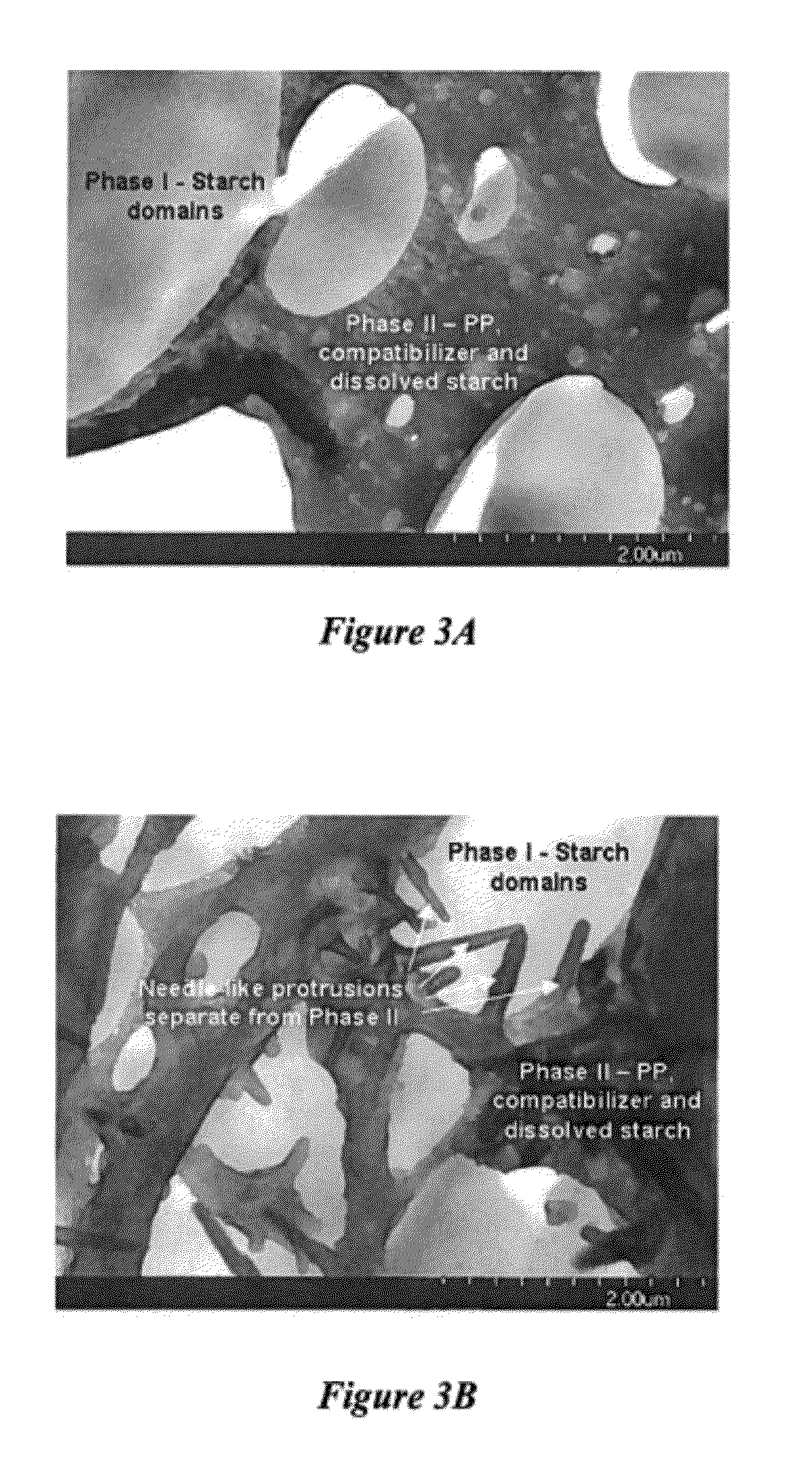Isosorbide-Plasticized Starch And Uses Thereof
a technology of plasticized starch and isosorbide, which is applied in the field of thermoplastic starch, can solve the problems of increasing the demand for plastics made from non-renewable resources, affecting the physical properties of polymer mixtures, and reducing the use of starch, so as to reduce thermal discoloration (browning) and high thermal stability
- Summary
- Abstract
- Description
- Claims
- Application Information
AI Technical Summary
Benefits of technology
Problems solved by technology
Method used
Image
Examples
example 1
[0048]This example illustrates the ability of molten isosorbide alone to substantially destructure ethoxylated starch.
[0049]Isosorbide (4.0 kg) (Archer Daniels Midland, Technical grade) was melted in a metal container in a 90° C. oven. Concurrently, a Baker-Perkins twin screw extruder (Model CT-25) equipped with 25 mm co-rotating screws having a 40:1 length-to-diameter ratio, separate liquid and powder feeding systems, and a strand die was preheated to achieve the temperatures indicated in the table below. The screw was configured to have high shear elements to assist in efficient destructering of starch in the presence of the plasticizer. Screw rotation was maintained at about 450 revolutions per minute (rpm) providing an extruder output rate of about 20 to about 40 pounds per hour depending upon the actual composition being run.
[0050]The liquid feeder reservoir was preheated to 80° C. and filled with molten isosorbide. The strand die was positioned above a silicone-coated conveyor...
example 2
[0057]This example illustrates the ability of a concentrated isosorbide / water solution (70 / 30 w / w) to substantially destructure ethoxylated starch.
[0058]A 70% w / w solution of isosorbide in water was prepared using 2019.5 grams of isosorbide and 865.5 g of distilled water. The solution was placed in the liquid feeder system described in Example 1, then heated to about 80° C. The powder and liquid feeding systems were adjusted to provide a 60 / 40 w / w ratio of ethoxylated starch / 70% isosorbide solution. The final weight ratio of this composition therefore was about 60% starch / 28% isosorbide / 12% water. The strands were extruded with adequate melt strength to be collected and pelletized. The resulting pellets were very clear, with an amber color. When these pellets were analyzed for % destructurization of the starch component, it was found that the destructurization ranged from about 98 to about 99%.
[0059]Comparative Example 3 and Examples 4 and 5 illustrate the effect of substituting low...
example 4
Thermoplastic Starch Blend Containing 5% Isosorbide
[0065]The procedure of Comparative Example 3 was repeated with the following exceptions. In a Henschel laboratory mixer (Model FML40), 1205.5 g sorbitol (Archer Daniels Midland), 250.0 g isosorbide (Archer Daniels Midland), 2870 g ethoxylated starch (Grain Processing Corp.), and 25 g magnesium stearate were combined and mixed at 1000 rpm for 4 minutes.
[0066]The liquid feeder reservoir was preheated to 80° C. and filled with refined glycerol. The strand die was positioned above a silicone-coated conveyor belt, the length and speed of which was selected to sufficiently cool and solidify the molten extruded strands prior to the strands entering a pelletizer, where they were chopped into small pellets.
[0067]The powder feeder and the liquid feeder were calibrated to dispense the starch mixture and glycerol such that a composition comprising about 13% glycerol, 24.1% sorbitol, 5% isosorbide, 57.4% starch, and 0.5% magnesium stearate (weig...
PUM
| Property | Measurement | Unit |
|---|---|---|
| length | aaaaa | aaaaa |
| RH | aaaaa | aaaaa |
| thick | aaaaa | aaaaa |
Abstract
Description
Claims
Application Information
 Login to View More
Login to View More - R&D
- Intellectual Property
- Life Sciences
- Materials
- Tech Scout
- Unparalleled Data Quality
- Higher Quality Content
- 60% Fewer Hallucinations
Browse by: Latest US Patents, China's latest patents, Technical Efficacy Thesaurus, Application Domain, Technology Topic, Popular Technical Reports.
© 2025 PatSnap. All rights reserved.Legal|Privacy policy|Modern Slavery Act Transparency Statement|Sitemap|About US| Contact US: help@patsnap.com



